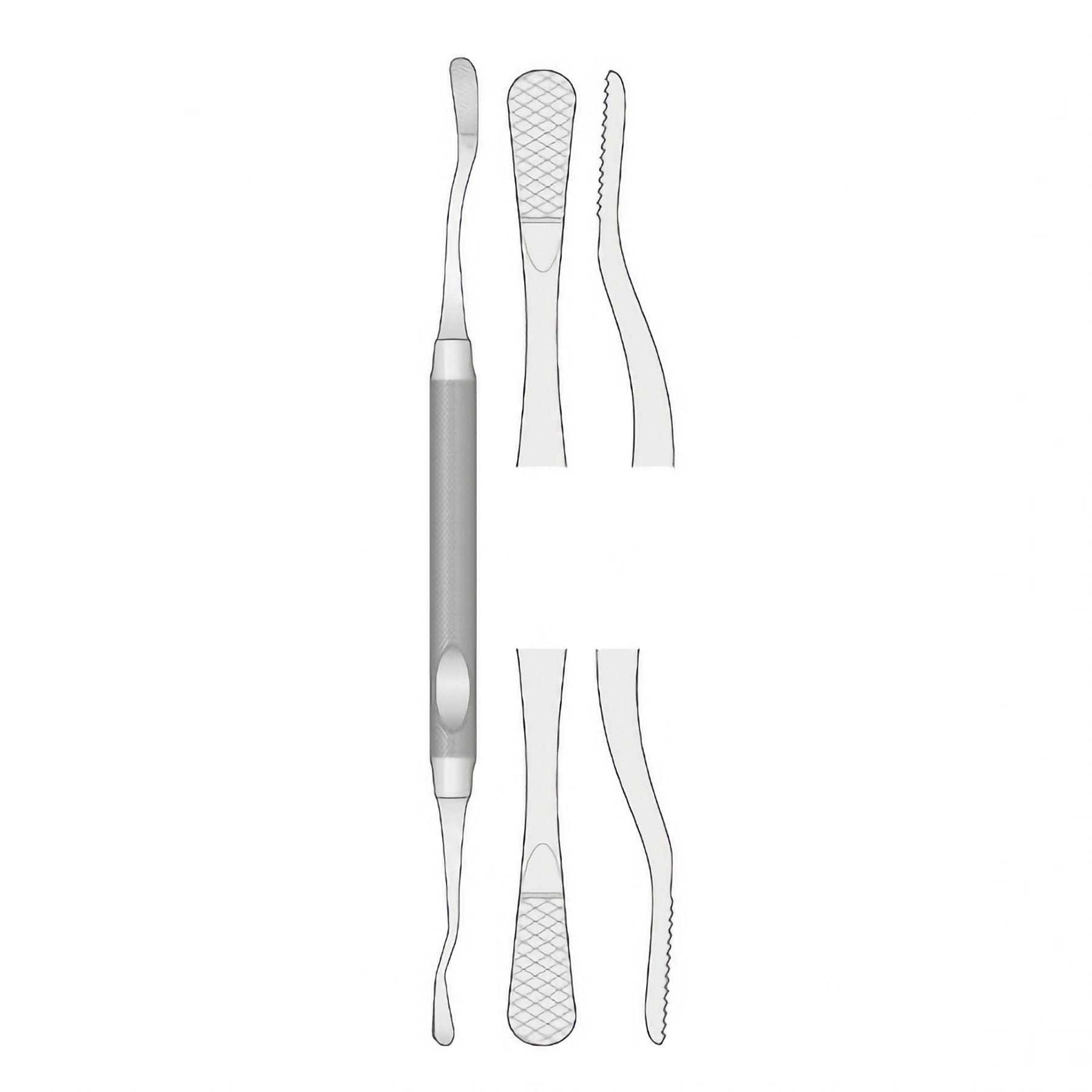The instruments used in dental surgery are very varied and are specially designed to perform various dental surgical procedures, this being an extension of the surgeon's fingers in which Focus all your skill. Some instruments are typical of oral surgery and many others come from general surgery or its specialties and from dentistry itself. In this article we will talk about simple surgical instruments, which are those that the surgeon manipulates with his own hands, that is, manual instruments that do not involve significant technological complexity.
If you want to know or simply review everything about this type of dental surgical instruments in order to always select the most appropriate one in each case, in this article we will take a tour of the different categories of instruments and we will offer you always the best options available. Keep reading and don't miss any detail.

Commonly, simple instruments are made up of three parts:
- A passive part that is usually a handle or a handle from which the instrument is grasped. According to each manufacturer, the handles will have their particular characteristics, the best ones will always be those that provide a better grip through grooves or irregularities. Some instruments, however, are double-ended and share the handle in the middle.
- The intermediate part, also called the neck or stem, is the one that joins the active part with the handle and has different shapes proportional to the use of the instrument and the areas to which it must facilitate access.
- Finally, the active part depends on the function of the instrument and is ultimately what gives it its name.
There are other simple surgical instruments that are made up of two components: the active part and the passive part joined by a screw or axis of rotation, some examples are scissors, forceps, tweezers , etc. Other instruments, on the other hand, have shapes that do not fall into this classification and this is the case of the anesthesia syringe or Carpule syringe, which we will discuss below.
Instruments for dental anesthesia
Anesthesia syringes
This classification includes glass syringes, disposable syringes, Yutil metal syringes and Carpule type syringes, which are by far the most used and therefore we will expand their description.
Carpule type syringe
The carpule-type syringes have great advantages over other types of syringes for the locoregional administration of anesthesia, some of which are their ability to aspirate by pulling the plunger back, the possibility of change the needles in an easy and fast way, the possibility of being sterilized without suffering damages and its easy control.
There are two types of Carpule type syringe and their use depends more than anything on the dentist's preferences. These are the Carpule Side-Loading Syringe and the Carpule Rear-Loading Syringe, which differ in the way the anesthesia tube is loaded. There are also different models of Carpule syringes that differ in the number of rings they have or in the way the fingers are positioned. We invite you to take a look at our wide variety of models and shapes of anesthesia syringes and also we recommend:
Carpule syringe for anesthesia - Vidu
The Carpule Vidu-type syringe is made of high-quality stainless steel and has three rings, one of which is open, for a secure and comfortable grip when applying anesthesia.
- Ergonomic and easy to use.
- Made of stainless steel.
- Autoclavable.
- Side load.
- With harpoon, allows aspiration.
- Detachable.

Surgical retractors
The purpose of using retractors in oral surgery is to facilitate visibility of the operative field by retracting the lips and cheeks and rejecting mucoperiosteal flaps detached from the bone. The separation of the tissues also prevents surgical trauma. There are many types of separators and the most important are:
Minnesota Separator
It owes its name to the dentistry school that devised its design and its purpose is to protect and remove flaps to give visual access and surgical instruments in the area of the upper maxillary tuberosity, although it can be used in any region of the mouth. You can find this product at Dentaltix and this is our recommendation:
GNZ Dental Cawood Minnesota Retractor
The GNZ Dental Cawood Minnesota Retractor is a high-quality instrument made of stainless steel.
- Measures 15 cm in length.
- Can be autoclaved.
- Perfect for tissue retraction in the oral area.

Farabeuf separator
This retractor is very useful to retract the lips from the operating field. It is available in different lengths and the most used is the medium size in depth and width. We recommend:
GNZ Dental Farabeuf Separator
GNZ Dental's Farabeuf retractor is specially designed for retraction of lips, tongues and cheeks during dental surgery.
- Made of stainless steel.
- Available in 12 and 15 cm.
- Autoclavable.

Langenbeck separator
It is used for the retraction of mucoperiosteal flaps. There are different sizes of this instrument, however, the one with medium and narrow valves is more useful. Our recommendation:
GNZ Dental Langenbeck Separator
The Langenbeck retractor from GNZ Dental is a surgical instrument designed to obtain optimal visibility of the operating field.
- Made of stainless steel.
- Length 22 cm.
- Lightweight and robust at the same time.
- Size: 40 x 11mm
- Autoclavable.

Commissure separator
It is a separator that is used, as its name indicates, to separate the corners of the lips and obtain better access and visibility. They are available in plastic and metal and are frequently used in intraoral photography techniques. Vidu offers you this product with a zero plastic footprint:
Vidu Type Y Cheek and Lip Retractor
The Vidu Y-type commissure retractor is a perfect option if you want to contribute to caring for the planet, since all the plastic from its weight and its packaging is compensated by the brand with the same amount of plastic collected from the Mediterranean Sea.
- Ideal for clinical procedures and photography.
- Transparent and non-reflective.
- Flexible and resistant.
- Contains 2 units in size L.
- Autoclavable.

Scalpel
Scalpel Handle
The scalpel is the instrument commonly used to make incisions. The most commonly used handles in dental surgery are number 3, followed by 5 and 7. If what you need is a number 3 handle, we recommend:
Handle of Scalpel Nº3 Vidu
The Vidu scalpel handle is an ergonomic and high quality instrument, designed to mount a scalpel blade in order to make surgical incisions.
- Available in flat and round shapes.
- Handle No. 3
- Autoclavable.

Scalpel blades
Scalpel blades are sold separately because they are disposable and removable. When assembling them on the handle, care must be taken not to damage the edge of the blade. The most commonly used sheet is number 15, followed by number 11 and number 12. Check out these sheets from Medicaline.
Medicaline Scalpel Blades
Medicaline disposable scalpel blades have the best value for money.
- Made of carbon steel.
- Available in number: 11, 12, 12D, 15, 15C and 20.
- Sterilized with gamma rays.
- Individually packaged.
- Box of 100 units.

Surgical scissors
Scissors are an essential instrument in dental surgery and there is a great variety of them, with different shapes, different lengths and different tips. Sometimes this wide variety makes it difficult to choose the appropriate one for each procedure, in general terms we will say that:
- The fine scissors are useful for cutting gums, however, the cut obtained with them in living tissue results in relatively blunt edges.
- The medium curved blunt tip scissors are used for dissecting anatomical planes.
- The Mayo scissors of 15 centimeters are used to cut threads and remove stitches. But be careful not to use the same scissors that you use to cut threads or other materials, also to cut fabrics.
- The Metzenbaum, Neumann and Dean scissors available in different sizes and shapes, are commonly used for dissecting or cutting tissue.
Periosteals
The periosteal s or detachers are used to separate or detach the mucosa from the bone periosteum in order to prepare a full-thickness flap. Instruments that fall into this category are mucoperiosteal peelers, blunt spatulas, curettes, and periosteals, among others.
These are some examples that you can find in Dentaltix:
Surgical forceps
Dissecting forceps
There are a large number of dissecting forceps, of different sizes, shapes, and thicknesses that determine their usefulness. Some of their applications are flap stabilization, especially in the suture procedure, in which they are very useful in bringing the edges closer, making the procedure faster and easier and traumatizing the tissues to a lesser degree.
An example of this category of dissecting forceps is the Adson tweezers, which has broad branches that taper towards the tip. This tweezers is especially useful in the anterior sector of the mouth. If you need an Adson tweezers, this is our recommendation:
Adson Surgical Tweezers with Teeth Vidu
Made of stainless steel, this is the ideal Tweezers for a perfect hold of the tissues without slipping.
- It measures 12.5 cm.
- Ergonomic design.
- Serrated tip for better grip.
- Autoclavable.

Pressure Forceps
The forcipression forceps are useful for holding or attracting tissue or for picking up bone fragments or other oral tissues or materials. An example of this type of forceps is the Kocher forceps which has sharp tips and saw teeth specially designed to hold tissue during surgery or to compress hemorrhagic tissue.
Carl Martin Curved Tip Kocher Forceps
The Carl Martin Kocher Surgical Forceps is designed to reinforce the grip of robust tissues.
- Made of stainless steel.
- Jagged.
- Length 15 cm.
- Curved tip.
- Autoclavable.

Hemostatic tweezers
Perhaps the best-known tweezers in this category is the small hemostatic tweezers or Halstead-type mosquito tweezers which commonly come in two varieties: curved and straight; and it can have another variation related to its tip that can be blunt with or without teeth. In addition, it is characteristic of this tweezers that it is subject to continuous pressure through a zipper closure, that is, you can release it and it will continue to apply pressure.
If what you need is a forceps to occlude vessels during a surgical procedure or to hold, grasp, attract or handle tissues, the most suitable instrument is the Halstead Mosquito tweezers without teeth of 12 .5 cm long. Some surgeons use this tweezers as a needle holder, but you should know that it is not an instrument indicated for this purpose.
If you want to incorporate a curved or straight mosquito tweezers into your arsenal, this is our recommendation:
Vidu Mosquito tweezers
The Vidu mosquito tweezers is the ideal instrument for the occlusion of blood vessels and subsequent hemostasis during surgery.
- Made of stainless steel.
- With zipper type closure.
- Available straight and curved.
- Autoclavable.

Surgical curettes
The surgical curettes, also called bone spoons, are useful for removing cysts, granulomas or other lesions contained in a cavity of the maxillary bones.
Their shapes vary according to their function, some are straight, others angled, and they can also be double-ended. There are also variations in size, diameter, depth and shape of its concavity. The excavators that are commonly used for dentin can also be used for curettage of small periapical lesions. Here are some examples of surgical curettes:
Gouge Pliers
The gouge Pliers is an instrument with two articulated branches that has active ends that are concave and sharp at the tips and on the sides. When there is no pressure on their arms, they are kept open by the presence of a spring. The Gouge pliers is used for the excision of hard tissues and there are different varieties of shape, size, types of arms, active ends, angulation, etc.
The gouge pliers are also useful in the removal of spicules during the procedure to regularize bone surfaces or edges. Although its shape is very similar to that of a dental pliers, this pliers is not designed for the extraction of dental roots and should not be used for this purpose, since contact with the tooth will damage its sharp edge. If you need a gouge plier forceps a 45º angle, take a look at this one from Bader:
Gouge Pliers 45º Bader
The Bader 45º angled Gouge Plier is a perfect option for regularizing bone surfaces.
- Length 14.5 cm.
- 45º angle in its active part.
- Made of stainless steel.
- Sharp edges and point.
- Autoclavable.

Bone files
The bone files are usually double-ended instruments, which have a file in their active part that has the function of pushing and pulling. It should be used with firm support and short, controlled finger movements. The purpose of this type of surgical instruments is to file and polish the edges of bone that have been mistreated or compressed after an extraction or other type of surgical intervention. At Dentaltix we recommend:
Bone scraper file Nº11/12 Bader
The Bader bone file is the appropriate instrument for filing and polishing the bone after an extraction or any other type of dental surgical procedure.
- Made of stainless steel.
- Double end.
- Available in two sizes: Nº 11 18 cm and Nº12 18.5 cm.
- Autoclavable.

Hatches or chisels
The chisels or also called surgery chisels are instruments that end with a bevel at their active end. There are chisels of different types, some with a bevel on one side, double or half round. For its use, an surgical hammer is required, so Therefore, its use in conscious patients is not indicated. You can imagine why!
In dental surgery this type of instrument is increasingly out of use and has been replaced by rotary instruments, although it is worth mentioning.
The indication of the Hatches or chisel is osteotomy, ostectomy, odontosections and tooth dislocations. Here are some examples:
Suture Instruments
We will finish this article like any good surgery, with the suture, and for this to be perfect we will need the appropriate instruments to hold the needles and suture threads
Needle Holder
The needle holders are the forcipression tweezers used to hold the suture needles. They have grooved tips in their active part and sometimes have a shaped notch. ellipsoidal to hold and position the needle in different positions. Some needle holders have a carbide coating on the serrations of the active part to increase their durability.
The handle of the needle holder has a zipper closure, which must always be closed when the needle or thread is picked up. The needle is always placed perpendicular to the axis of the instrument, taking hold at its midpoint.
The needle holders that are most frequently used are those that are between 15 and 20 cm. in length, the most common being 17 cm. The most widely used models are the needle holder from Mayo, Hegar, Crile-Wood, Catroviejo and Lichtenberg among others. What do we recommend? Check out!
Mayo Needle Holder Vidu
With Vidu's Mayo Needle Holder you won't have to worry about getting a firm grip on your suture needles. In addition, its tungsten carbide tip will increase its useful life.
- Length 16 cm.
- Made of stainless steel.
- Zip closure.
- Autoclavable.

Castroviejo Needle Holder Vidu
Vidu's Catroviejo needle holder will get its maximum performance in your microsurgery sutures.
- Knurled tips to improve the grip of the needle.
- Specially designed for dental microsurgery.
- Made of stainless steel.
- Zip tab closure.
- Autoclavable.

In short, oral surgery uses a large number of elements specially designed and designed to help the surgeon obtain the best results. We can divide the simple surgical instruments into the following, in addition to some examples:
- Instruments for anesthesia
- Anesthesia syringes: eg Carpule type syringe
- Surgical retractors or retractors
- Minnesota Stripper
- Farabeuf separator
- Langenbeck separator
- Commissure retractor
- Scalpels
- Scalpel handle: for example, numbers 3, 5 and 7
- Scalpel blades: for example, numbers 11, 12, 12D, 15, 15C and 20
- Surgical scissors
- Iris Scissors
- Mayo scissors
- Metzenbaum scissors
- Neumann scissors
- Dean Scissors
- Periosteals
- Molt's periosteal tube
- Freer periosteal valve
- Williger periosteal valve
- Surgical forceps
- Dissecting forceps: eg Adson forceps
- Pressure forceps: eg Kocher forceps
- Hemostatic forceps: for example, Mosquito forceps
- Surgical curettes
- Lucas Curette
- Hemingway Curette
- Gouge Pliers
- Bone files
- Chisel or chisel
- Suturing instruments
- Mayo Needle Holder
- Catroviejo Needle Holder
- Hegar Needle Holder
- Crile-Wood Needle Holder
- Lichtenberg Needle Holder
We have reached the end, we hope you liked our article and that it served as a buying guide. Do not forget to follow us on our social media and keep an eye on our next publications to always be aware of the latest news in the dental sector. Until next time!














